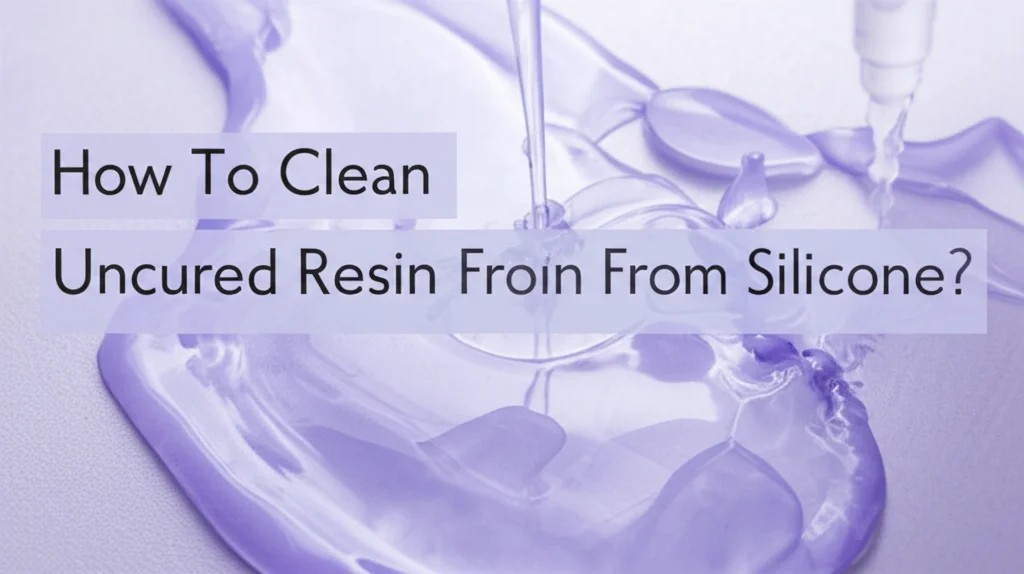· DIY & Crafts · 6 min read
How To Clean Uncured Resin From Silicone?

Tackling Sticky Situations: How To Clean Uncured Resin From Silicone?
Ever poured resin into a silicone mold, only to realize you made a mistake or need to reuse the mold before the resin fully cures? It’s a common frustration for resin artists! Uncured resin clinging to silicone can feel like a disaster, but don’t worry – it’s usually salvageable. This article will guide you through several effective methods for cleaning uncured resin from silicone molds, ensuring you can get back to creating beautiful pieces. We’ll cover everything from simple tools to helpful solvents, and even preventative measures to avoid this sticky situation in the first place. Let’s dive in and rescue those molds!
Quick Answer:
To clean uncured resin from silicone, gently scrape away excess resin with a plastic tool, then use isopropyl alcohol (91% or higher) to dissolve the remaining residue. Allow the alcohol to sit for a few minutes, then gently scrub and rinse with water.
Takeaway:
- Gently scrape excess resin.
- Use isopropyl alcohol for dissolving residue.
- Rinse thoroughly with water.
- Prevent sticking with mold release agents.
Why Does Resin Stick to Silicone?
Resin, in its uncured state, is incredibly sticky. Silicone, while flexible and durable, has a naturally slightly tacky surface. This combination makes it easy for uncured resin to bond to the mold. Understanding why this happens is the first step in preventing and resolving the issue. Different types of resin have varying levels of stickiness, with some formulas being more prone to clinging than others. Temperature and humidity can also play a role; warmer temperatures often make resin tackier. Finally, improper mold preparation – like skipping a mold release agent – significantly increases the chances of resin sticking.
The Gentle Approach: Scraping Away Excess Resin
Before reaching for solvents, start with the simplest method: physical removal. Carefully scrape away as much of the uncured resin as possible using a plastic scraper, a silicone spatula, or even a flexible plastic knife. Avoid using metal tools, as these can damage the delicate silicone mold. Applying gentle, consistent pressure is key. Don’t force it; you want to remove the bulk of the resin without tearing or distorting the mold. This initial scraping will significantly reduce the amount of resin you need to dissolve later.
Isopropyl Alcohol: Your Resin-Dissolving Friend
Isopropyl alcohol (also known as rubbing alcohol) is a fantastic solvent for uncured resin. The higher the concentration, the better – 91% or higher is recommended. Pour a small amount of isopropyl alcohol directly onto the resin residue. Let it sit for 5-10 minutes to allow the alcohol to break down the resin. You’ll notice the resin becoming less sticky and easier to remove. After soaking, gently scrub the area with a soft brush (like an old toothbrush) or a clean cloth. Finally, rinse the mold thoroughly with warm water to remove any remaining alcohol and dissolved resin. If you’re looking for more cleaning solutions, you might find this article on https://www.beacleaner.com/how-to-clean-kitchen-mats/ helpful for general cleaning tips.
Choosing the Right Isopropyl Alcohol Concentration
The concentration of isopropyl alcohol matters. While 70% isopropyl alcohol can work, it’s significantly less effective than 91% or higher. The higher concentration contains less water, making it a more potent solvent for the resin. Using a lower concentration may require longer soaking times and more scrubbing, potentially increasing the risk of damaging the silicone mold. Always check the label to ensure you’re using a concentration suitable for dissolving resin.
Alternative Solvents: When Isopropyl Alcohol Isn’t Enough
While isopropyl alcohol is usually sufficient, some resin formulations are particularly stubborn. In these cases, you might consider alternative solvents, but always test in an inconspicuous area first to ensure they don’t damage the silicone. Acetone is a powerful solvent, but it can degrade some types of silicone, so use it with extreme caution and only as a last resort. Resin manufacturers sometimes offer specific cleaning solutions designed for their products; these are often the safest and most effective option. Remember to always work in a well-ventilated area when using any solvent.
Preventing Resin From Sticking: Mold Release Agents
The best way to clean uncured resin from silicone is to prevent it from sticking in the first place! Mold release agents create a barrier between the resin and the silicone, allowing for easy demolding. There are several types available:
- Silicone Sprays: These are widely available and easy to use. Apply a light, even coat to the mold before pouring the resin.
- Mold Release Waxes: These provide a more durable barrier, especially for complex molds.
- Soap and Water: A simple solution for some resins. Ensure the mold is completely dry before pouring.
Using a mold release agent is a small investment that can save you a lot of time and frustration. If you’re struggling with general floor cleaning, this article on https://www.beacleaner.com/how-to-clean-vinyl-plank-flooring/ might offer some useful insights.
Cleaning Silicone Molds After Curing: Maintaining Your Tools
Even if resin does cure in your silicone mold, proper cleaning is essential. Once the resin is fully cured, it should pop out of the mold relatively easily. If there’s any residue, you can use warm, soapy water and a soft brush to remove it. Avoid abrasive cleaners, as these can scratch the silicone. Regular cleaning will keep your molds in good condition and extend their lifespan. Proper mold care is crucial for consistent results and beautiful resin creations.
Frequently Asked Questions (FAQs)
Q: Can I use baby oil to clean uncured resin from silicone?
A: While some people suggest baby oil, it’s not as effective as isopropyl alcohol and can leave a greasy residue that interferes with future resin pours. Isopropyl alcohol is the preferred method for dissolving uncured resin.
Q: Will vinegar damage my silicone molds?
A: Vinegar is generally safe for silicone, but it’s not a strong solvent for uncured resin. It might help loosen some residue, but it won’t dissolve the resin like isopropyl alcohol.
Q: How long can uncured resin sit in a silicone mold before it becomes impossible to remove?
A: The longer the resin sits, the harder it becomes to remove. Ideally, address uncured resin within a few hours. After 24 hours, it will likely start to cure and become much more difficult to clean.
Q: Is it safe to reuse a silicone mold after cleaning it with isopropyl alcohol?
A: Yes, as long as you rinse the mold thoroughly with warm water to remove all traces of alcohol. Ensure the mold is completely dry before pouring new resin.
Conclusion: Keeping Your Resin Projects Flowing
Cleaning uncured resin from silicone molds doesn’t have to be a stressful experience. By following these simple steps – gentle scraping, isopropyl alcohol application, and preventative mold release agents – you can keep your molds in excellent condition and continue creating stunning resin art. Remember, prevention is key! Investing in a good mold release agent will save you time and effort in the long run. Don’t let a sticky situation halt your creativity. Now that you know how to clean uncured resin from silicone, you can confidently tackle any resin project that comes your way. If you’re looking for more cleaning advice, check out this article on https://www.beacleaner.com/how-to-clean-kitchen-sink-mats/ for helpful tips around the house.




